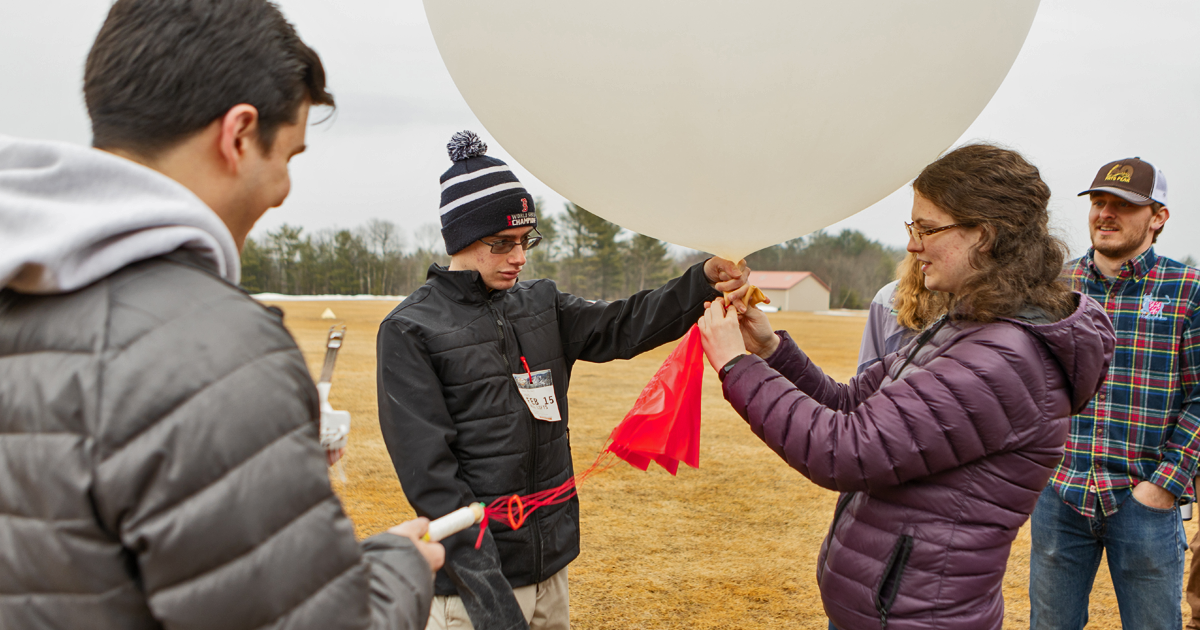NASA Solar Eclipse Project: “A great example of Cluster Learning”

Plymouth State’s Cluster Learning model emphasizes projects that go beyond classroom walls—sometimes far beyond. Interdisciplinary teams of PSU students and faculty are part of a nationwide effort that will explore phenomenon miles above the Earth as part of the NASA funded, Nationwide Eclipse Ballooning Project.
PSU is among colleges and universities across the country studying atmospheric effects during solar eclipses and will send two teams to both New Mexico in October 2023 and to northern New Hampshire in April 2024. Meteorology Professor Eric Kelsey will lead one team and the second will be co-led by Art Professor Kimberly Anderson Ritchie and Art Education Coordinator Erin Sweeney.
The mission of NASA’s Science Activation Program is to broaden STEM participation in higher education. The Ballooning Project broadens STEM learning and participation, and PSU received a $208,445 grant from NASA to field its teams. The 16 participating PSU students come from a variety of majors, including meteorology, climate studies, art and art education, political science, and psychology.
Everyone involved—even Ritchie and Sweeney—attended at least some of Kelsey’s “Exploring Solar Eclipses” course this semester. “This is a great example of Cluster Learning,” Kelsey says. “The University embraces hands-on education that breaks down silos between programs.”
Fifty-five teams in all from across the nation will be launching weather balloons from different locations impacted by this fall’s solar eclipse. Balloons will be launched every hour during a 30-hour period and will travel into the stratosphere, up to 20 miles high, collecting data on temperature, humidity, ultraviolet rays, air pressure, and wind speed and direction. Thirty-six of the 55 teams will have balloons with cameras, and this scope of data collection will exceed that of any previous solar eclipse research campaign.

Kelsey will serve as a regional “pod lead” overseeing the PSU group and teams from SUNY Albany, SUNY Oswego, and the University of New Haven. He will help train team leaders on equipment and logistics.
“The art program often is working across disciplines and in Cluster projects,” says Ritchie. “For a lot of students, coming here is about the environment, the lakes, mountains, etc., so we advocate this through classes and projects. Art and science working together at Plymouth State is a long-term thing.”
PSU teams are working on the atmospheric science aspect of the project, launching the weather balloons and looking at the data, while others are focused on engineering. Teams will be scattered along the eclipse path in various states, and the PSU contingents will journey this fall to Moriarty, NM, on historic Route 66.
“This is a great way to get students involved in a fantastic and fascinating experience,” Kelsey says. “I think it is something students can be excited about and it will make an impression on them for the rest of their lives.”
Genevieve Picciano ’24G, an applied meteorology student and project assistant, will be using the data for her thesis. “The project is a really great opportunity so I couldn’t not take it,” she says. In May, PSU will be hosting representatives from the other schools in Kelsey’s pod for a training weekend, and Picciano will be heavily involved with the equipment the visitors will be using.
“This is cool not only for me but other students at Plymouth State and the Plymouth State community,” says Picciano. “It’s creating a partnership with other schools.”
PSU art students will be working side-by-side with meteorology peers on the launching and data collection. They will also be creating eclipse art projects, and non-art majors have been invited to create works as well.
Emily Roy ’24, an art and psychology double major, created an independent study class on ways to record solar eclipses through art. She plans to have several pieces in the exhibit, including possibly employing the used weather balloons.
“I tend to do things across disciplines, so this sounded like an awesome opportunity,” says Roy. “This is something that sets me apart as far as a résumé builder, since solar eclipses are not a typical thing that an art major experiences. It’s cool to bring my perspective to something like this.
“I hope that along with the data we record we make sure we are grabbing people’s attention about solar eclipses and their effects with our art,” Roy continues. “I am excited about the research and this is also a huge opportunity for artists to get noticed by a different community, and for our community to learn about what scientists are doing.”

